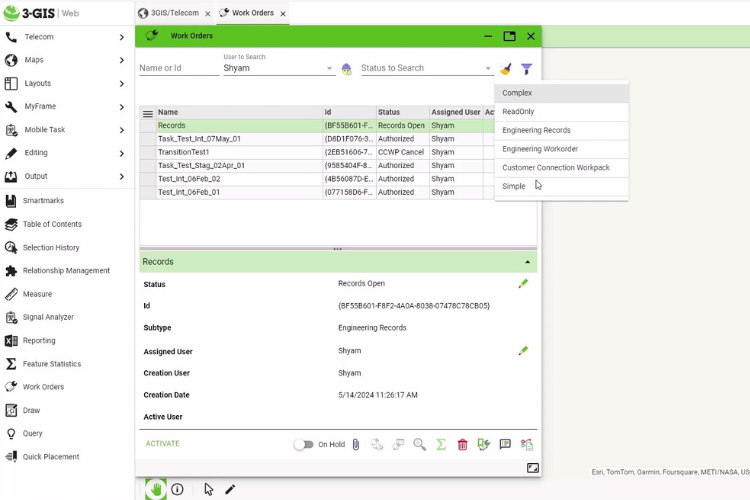As Ericsson Network Engineer (ENE) reaches its end of life, it's crucial for telecom companies to transition to a more advanced, future-proof solution. In this post, we’ll compare the work order management functionalities of Ericsson Network Engineer and 3-GIS | Web to aid in the transition between platforms—highlighting the similarities and differences in handling work orders, from planning and design to construction and finalization.
Ericsson Network Engineer
In Ericsson Network Engineer, work order management is a structured process that follows a well-defined workflow. The interface displays various types of work orders and their current statuses, allowing engineers to start, transition, and complete tasks efficiently. It operates as such:
Workflow
- Initiation: Engineers start a work order, transitioning it to the necessary phase.
- Construction: Fieldwork is conducted based on the work order details.
- Supervision: A supervisor reviews and completes the work order.
- Customization: Organizations can configure unique workflows based on their specific needs. This includes setting approval mechanisms, defining lifecycle lengths, and more.
Key components
- Status of work orders: Indicates whether a work order is in the engineering, construction, or as-built state.
- Work order types: Defines the lifecycle and transitions of the work order.
- Transitions: Manages the movement of work orders from one state to another.
3-GIS
Transitioning to 3-GIS introduces 3-GIS | Web, a web-based client that enhances data accessibility and user flexibility, and 3-GIS | Admin, a web-based, administrative application (equivalent to a toolbox in Ericsson Network Engineer) that allows graphical management of records and seamless rules configuration. Here's how work order management is realized with 3-GIS:
Workflow
- Work orders tool: Users can create, manage, and transition work orders through a single interface.
- Statuses: Multiple statuses can be created, modified, and managed. For instance, an "Open" status can be set as the initial state where work orders can be activated and worked upon.
- Configuration: Similar to Ericsson, 3-GIS allows organizations to configure workflows tailored to their requirements. This includes defining work order types and the respective lifecycle, whether short or long.
Key components
- Work order types and statuses: Users can configure various work order types and statuses to match their organizational needs.
- Lifecycle management: Each work order type can have a customized lifecycle, enabling flexible management.
- Transitions: Users can transition work orders between statuses, ensuring a smooth workflow. For example, an "Authorized" work order can be transitioned to "Complete" or "Cancel," depending on its current status.
Key differences and similarities
While both systems aim to streamline work order management, there are notable differences and similarities:
Interface
- Ericsson Network Engineer: Uses a thick client application. Allows for customization.
- 3-GIS: Entirely web-based, enhancing accessibility and ease of use. Allows for extensive configurability of workflows, statuses, and transitions, enabling organizations to tailor the process to their needs without the need of custom development or vendor support.
APIs and integrations
- Ericsson Network Engineer: Integrations between Ericsson Network Engineer and other systems require custom services or extensions to support them.
- 3-GIS: 3-GIS | Web integrations leverage RESTful APIs to enable the creation of work orders, along with updates to their status and feature associations outside of the system.
Transition management
- Both systems manage transitions between different work order statuses, ensuring a clear workflow from initiation to completion.
User interaction
- Ericsson Network Engineer: More traditional, desktop-based interaction.
- 3-GIS: Modern, web-based interaction that supports real-time updates and accessibility from various devices.
Making the transition
Both Ericsson Network Engineer and 3-GIS | Web offer robust work order management functionalities, catering to the needs of network management professionals. While Ericsson Network Engineer provides a foundation with its thick client interface, 3-GIS enhances the user experience with its web-based, flexible, and accessible platform. Organizations transitioning to 3-GIS can expect a seamless adaptation of their workflows with the added benefits of modern technology, scalability, and user-friendly interfaces.
Check out the below video for a detailed walkthrough.



